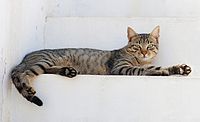
Photo from wikipedia
Contrafreeloading is the willingness of animals to work for food when equivalent food is freely available. This behavior is observed in laboratory, domesticated, and captive animals. However, previous research found… Click to show full abstract
Contrafreeloading is the willingness of animals to work for food when equivalent food is freely available. This behavior is observed in laboratory, domesticated, and captive animals. However, previous research found that six laboratory cats failed to contrafreeload. We hypothesized that cats would contrafreeload in the home environment when given a choice between a food puzzle and a tray of similar size and shape. We also hypothesized that more active cats would be more likely to contrafreeload. We assessed the behavior of 17 neutered, indoor domestic cats (Felis catus) when presented with both a food puzzle and a tray across ten 30-min trials. Each cat wore an activity tracker, and all sessions were video recorded. Cats ate more food from the free feed tray than the puzzle (t (16) = 6.77, p < 0.001). Cats made more first choices to approach and eat from the tray. There was no relationship between activity and contrafreeloading, and there was no effect of sex, age, or previous food puzzle experience on contrafreeloading. Our results suggest that cats do not show strong tendencies to contrafreeload in the home environment, although some cats (N = 4) ate most food offered in the puzzle or showed weak contrafreeloading tendencies (N = 5). Eight cats did not contrafreeload. Cats who consumed more food from the puzzle, consumed more food in general, suggesting a relationship between hunger and effort. Further research is required to understand why domestic cats, unlike other tested species, do not show a strong preference to work for food.
Journal Title: Animal cognition
Year Published: 2021
Link to full text (if available)
Share on Social Media: Sign Up to like & get
recommendations!